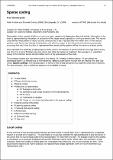Files in this item
Sparse coding
Item metadata
| dc.contributor.author | Foldiak, P | en |
| dc.contributor.author | Endres, D M | en |
| dc.coverage.spatial | 2984 | en |
| dc.date.accessioned | 2008-05-28T08:15:13Z | |
| dc.date.available | 2008-05-28T08:15:13Z | |
| dc.date.issued | 2008 | en |
| dc.identifier.citation | Scholarpedia 3(1): 2984 January 2008 | en |
| dc.identifier.other | StAndrews.ResExp.Output.OutputID.17616 | en |
| dc.identifier.uri | https://hdl.handle.net/10023/494 | |
| dc.identifier.uri | http://www.scholarpedia.org/article/Sparse_coding | |
| dc.description | The(frequently updated) original version is avalable at http://www.scholarpedia.org/article/Sparse_coding | en |
| dc.description.abstract | Mammalian brains consist of billions of neurons, each capable of independent electrical activity. Information in the brain is represented by the pattern of activation of this large neural population, forming a neural code. The neural code defines what pattern of neural activity corresponds to each represented information item. In the sensory system, such items may indicate the presence of a stimulus object or the value of some stimulus parameter, assuming that each time this item is represented the neural activity pattern will be the same or at least similar. One important and relatively simple property of this code is the fraction of neurons that are strongly active at any one time. For a set of N binary neurons (which can either be 'active' or 'inactive'), the average (i.e., expected value) of this fraction across all information items is the sparseness of the code. This average fraction can vary from close to 0 to about 1/2. Average fractions above 1/2 can always be decreased below 1/2 without loss of information by replacing each active neuron with an inactive one, and vice versa. Sparse coding is the representation of items by the strong activation of a relatively small set of neurons. For each stimulus, this is a different subset of all available neurons. | en |
| dc.format.extent | 96557 bytes | |
| dc.format.extent | 2541 bytes | |
| dc.format.mimetype | application/pdf | |
| dc.format.mimetype | text/plain | |
| dc.language.iso | en | |
| dc.subject | sparse coding | en |
| dc.subject | computational neuroscience | en |
| dc.subject | neurons | en |
| dc.subject | neural code | en |
| dc.title | Sparse coding | en |
| dc.type | Journal article | en |
| dc.audience.mediator | School : Psychology | en |
| dc.publicationstatus | Published | en |
| dc.status | Peer reviewed | en |
This item appears in the following Collection(s)
Items in the St Andrews Research Repository are protected by copyright, with all rights reserved, unless otherwise indicated.

